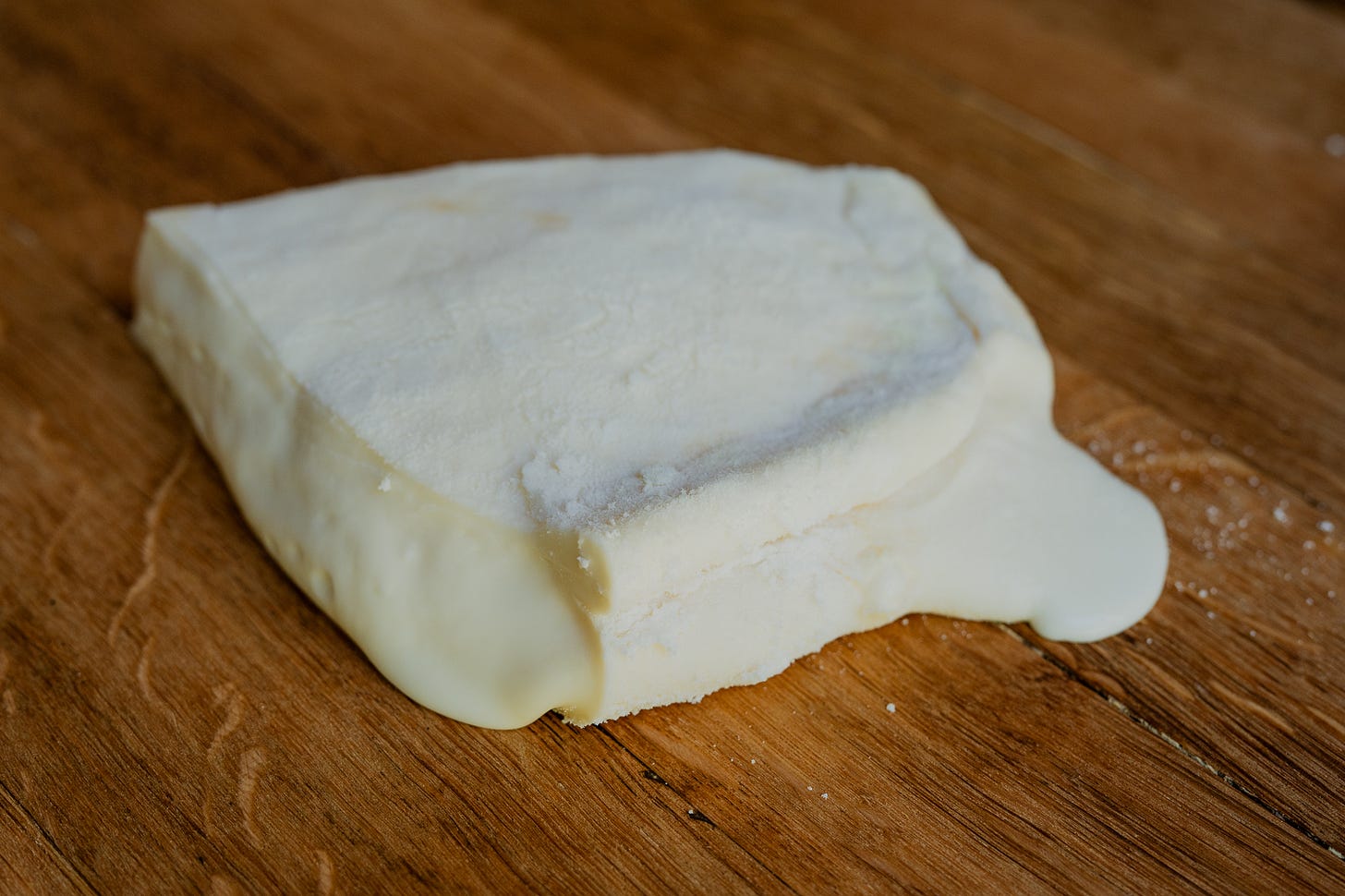While living in Italy, I couldn’t get enough of a fresh cheese called Stracchino. Also known as Crescenza (similar but released earlier), Stracchino represents a family of cheeses traditionally made from the milk of cows driven up and down the Alps from valleys in the Winter to mountain pastures in the Spring. The much-valued milk of these weary cows (from the Lombard dialect word stracco meaning “tired”) was said to have higher fat and protein content, flavor-enhancing fatty acids, and the aroma of “hay” from their diet of Alpine meadow grasses. In the past, Stracchino was made seasonally by traditional artisan methods. Now, it is made in large-scale, year-round production from the milk of well-rested dairy cows in the northern provinces of Lombardy, Piedmont, Veneto, and neighboring regions.
Stracchino is a mild, fresh cheese with no rind, snow-white complexion, and a glossy creaminess that melts in your mouth. In the aftertaste, it leaves a faint bitterness like milk does. Perhaps because of its freshness and fragility or lack of familiarity among cheese-loving consumers, it is a rare find in cheese counters. But now we have an equally satisfying alternative available in the Bay Area. Franklin’s Teleme cheese seems to have been directly modeled after Stracchino. Young and fresh it is held together by a tender rind developed over several weeks of aging in dry air. Uncut, its square shape resembles a swollen version of Italian Taleggio. If you love mild, white, voluptuously creamy cheese without the often-malodorous effects of microbial ripening, this is the cheese for you.
Franklin joined his father in making Teleme in the 1980s, the third of a generation of cheesemakers who followed in his grandfather’s footsteps. He continued making batches until the early 2000s when he sold his company and moved to the East Coast. We would have lost access to Teleme altogether were it not for the fact that Maine was not a fit for his family. He returned to California a short year later and resumed production in a rented facility. Then in 2018, Franklin went dark until just last summer when his cheese reemerged. Thankfully, the 78-year-old heir to Teleme is now back cutting the curds with the help of his son Adam who I hope will open the latest chapter in this generation’s old cheese.
The origins of California Teleme are murky. Franklin himself said, “Other companies made it at different times, but my family has made it since the beginning—and it was my grandfather who more or less created it in the 1920s”. It appears likely there was no single inventor. The name is curious but similar cheeses provide clues: Turkish Teleme peyniri was made by roaming shepherds and goatherds and served as their principal form of sustenance while tending their flocks. Warm goat or sheep milk was naturally coagulated with the foraged leaves, branches, and the milk-like sap of wild fig trees. And then there is Romanian Telemea, and Greek Telemes, semi-soft cheeses made from sheep or cow’s milk. Both derive their salty tang from being stored in brine. Having never tried either, they sound very much like Feta. There is no record that Teleme, the new world cheese, was ever brined. It is most likely that the name Teleme traveled with immigrants to California, and we know anecdotally that it reflects the contribution of Bay Area cheesemakers in the early decades of the 20th century, perhaps even to their unwitting collaboration. Michael Salzman wrote in Culture Magazine: “In 1927, Franklin Peluso’s grandfather, Giovanni, was inspired by the success of a cheese called telemea made by Greeks in the Bay Area, so he played around with re-engineering it. Despite the similar name, Giovanni’s cheese was distinct…He envisioned it as a ripened Stracchino reminiscent of those made in Northern Italy. And there was already a market awaiting it, San Francisco’s swelling Italian population.”
Franklin’s Teleme is like the creamiest Jack cheese you can imagine with a tender rind and glossy paste. It speaks directly of fresh milk and is very mildly acidic. You reach for flavor but realize you are utterly distracted by its velvety mouthfeel somewhere between room-temperature butter and the weight of solid cream cheese. It is formed into a pillowy square that heaves like rising bread when just released. The white dusting which looks at first like a fine mold bloom on its surface is actually rice flour, there to absorb residual moisture as the skin dries. Former Sales Director, Jack Eisenstadt described it aptly as a “big Italian cheesecake dusted with rice flour.”
Keep reading with a 7-day free trial
Subscribe to Notice! to keep reading this post and get 7 days of free access to the full post archives.





